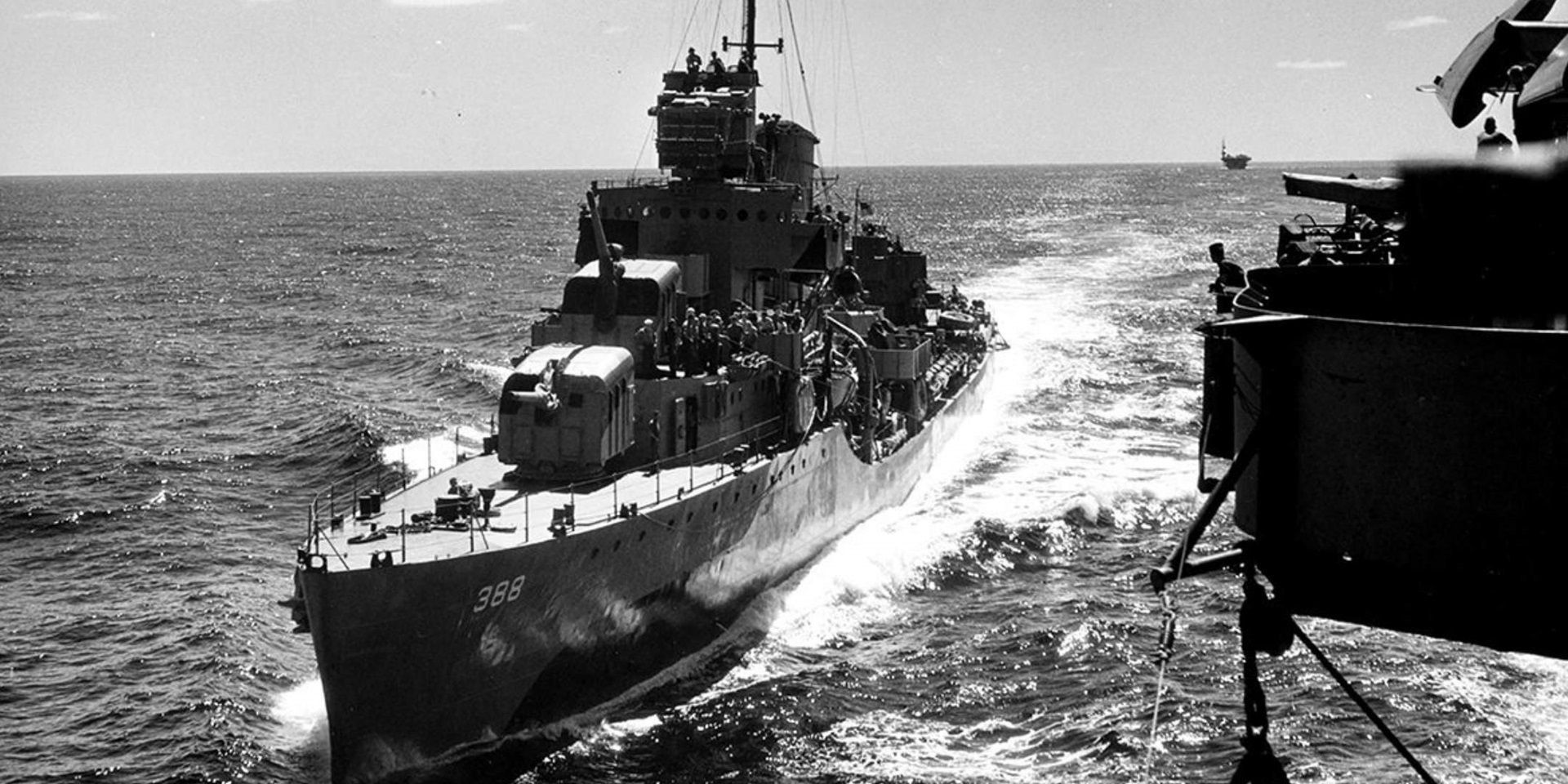
To the men who served aboard ‘The Lucky Ship’ … it was USS Helm.
by Russell Dority
She was given hull number DD388. Later in the ship’s career, she was known to other ships and crews she escorted as ‘The Galloping Ghost of the Queensland Coast’.
To the men who served aboard ‘The Lucky Ship’ … she was USS Helm.
Named after Rear Admiral James Helm, the Helm was a Bagley Class Destroyer of 1500 tonnes (light) launched in May 1937 at the Norfolk Navy Yard in Virginia and commissioned in October 1937. A fighting ship, she was armed with four 5 inch/38 caliber* guns, which would prove to be the best dual-purpose gun in the future Second World War, and a very heavy torpedo armament of sixteen 21-inch tubes.
This may sound impressive but the MK13 torpedo was very unreliable; either running too deep or failing to explode on contact. It’s range was fairly short, a feature made worse by the sailors’ habit of draining the alcohol out of the propulsion tanks to mix with their orange juice (to this day in the US Navy, illegal alcohol on board ships is called ‘torpedo juice’).
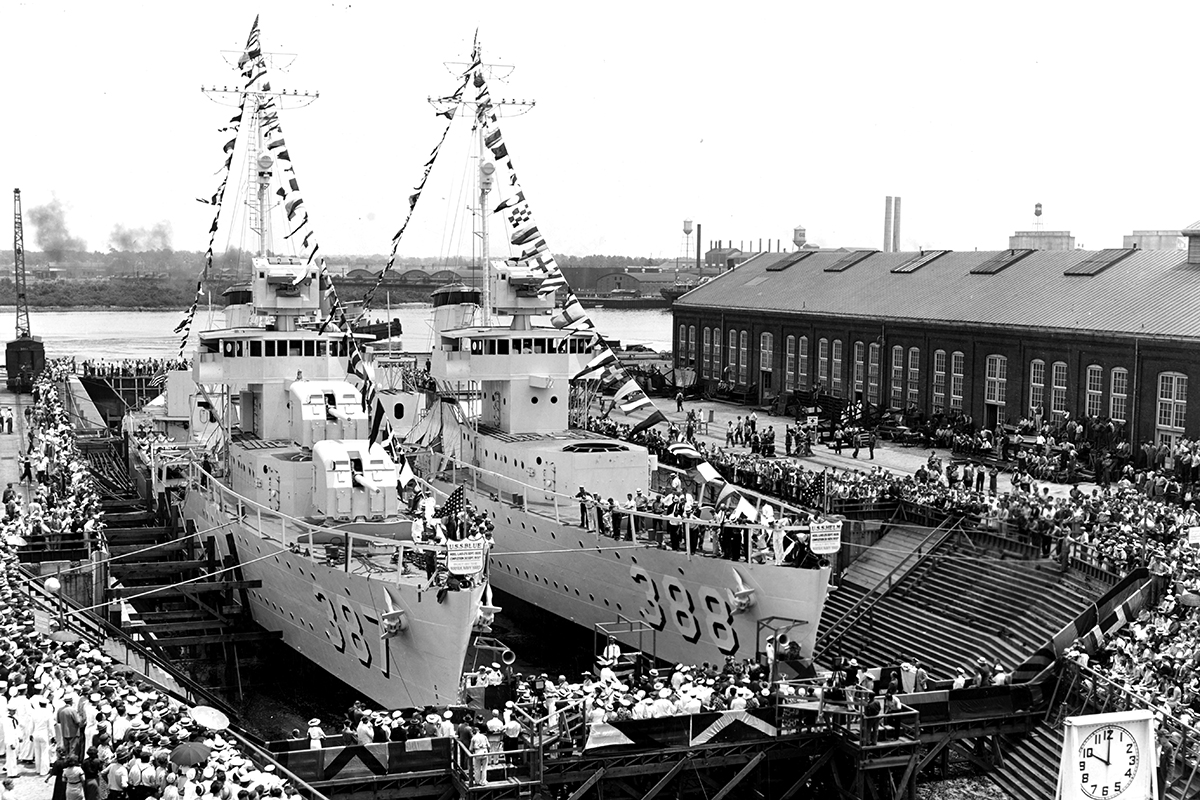 USS Blue (DD-387), left, and USS Helm (DD-388) at the Norfolk Navy Yard, 27 May 1937. Image: USN History And Heritage Command.
USS Blue (DD-387), left, and USS Helm (DD-388) at the Norfolk Navy Yard, 27 May 1937. Image: USN History And Heritage Command.
My father, William “Bill” Dority joined the Helm just before she was commissioned, after training at the Great Lakes Naval Training Center – just outside of Chicago where he was born. By the end of World War II, more than one million sailors had been trained there.
After a shakedown cruise, the Helm operated in the Caribbean until March 1938 when she joined the USN Atlantic Squadron as an escort to Carrier Division 2. In May 1939, the ship was transferred to the US west coast, operating out of San Diego. As relations with Japan deteriorated, the fleet was transferred to Pearl Harbor in Hawaii.
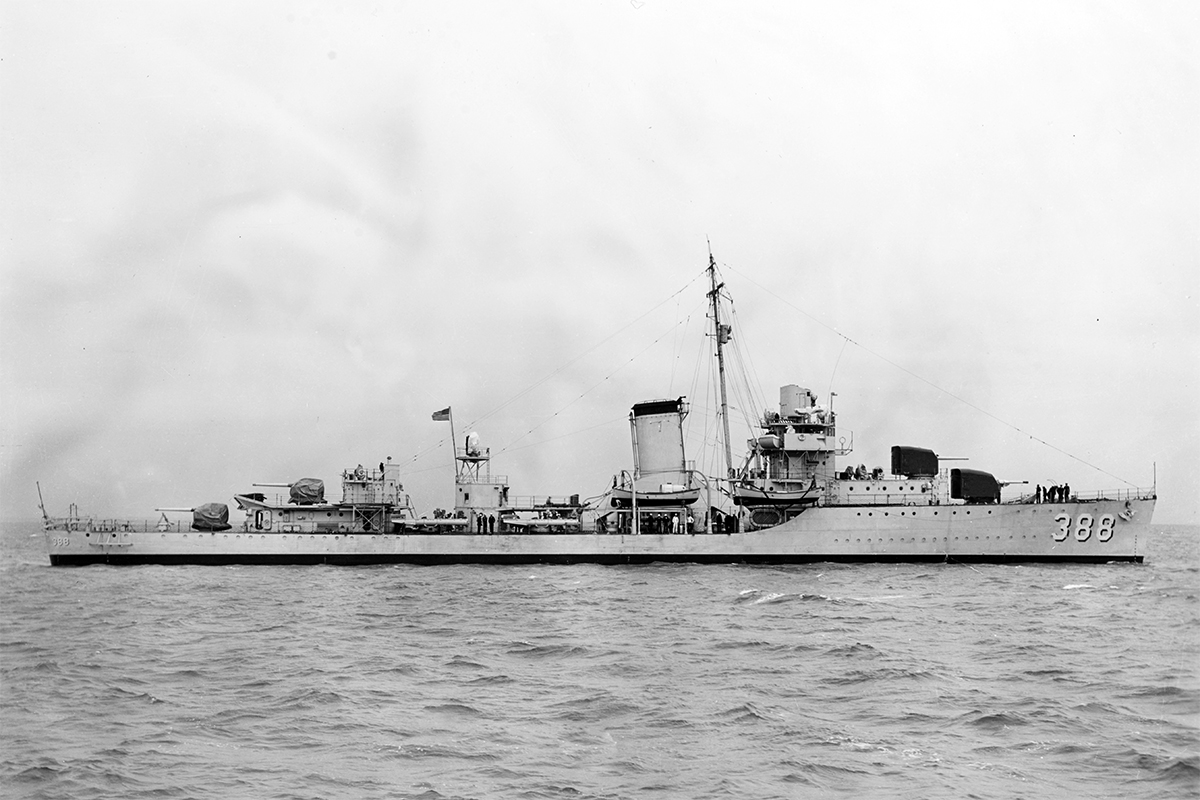 USS Helm, circa 1937-39. Image: USA National Archives.
USS Helm, circa 1937-39. Image: USA National Archives.
1941 Entering the War
On the morning of 7 December 1941, USS Helm was the only ship underway when the Japanese attacked Pearl Habor.
1942 Battles in the Pacific
In February 1942 Helm escorted the aircraft carrier USS Saratoga back to California for repairs after she was torpedoed by a Japanese submarine shortly after the unsuccessful attempt by the USN to relieve the besieged military base on Wake Island.
In California, Helm was fitted with six new AA (anti-aircraft) guns and repairs made to damage from Pearl Harbor. Returning to Hawaii the ship escorted an advance party to the New Hebrides arriving at Efate on March 19. When they came ashore in the beautiful harbour the crew were amazed to find only male islanders in the villages. When asked where all the women were the locals just pointed to the mountains … the reputation of the US Navy had preceded them.
In early May, the Helm was attached to Task Force 44. This was a joint Australian and American unit. While operating in the Coral Sea ,the Helm was sent to look for the missing freighter John Adams, rescuing 13 survivors from a life boat on May 9, then spending another 10 days searching for the survivors of the oiler USS Neosho and the destroyer USS Sims both victims of the Battle of the Coral Sea.
Four life rafts were sighted and the Helm sent its whaleboat out to pick up the men. Of the 68 who had boarded the rafts, only four were still alive. My father had to remove the dog tags from the dead sailors and deflate their life jackets so they could be committed to a watery grave, as they could not take the bodies on board. Shortly after, the Helm then headed for Brisbane to drop off the survivors.
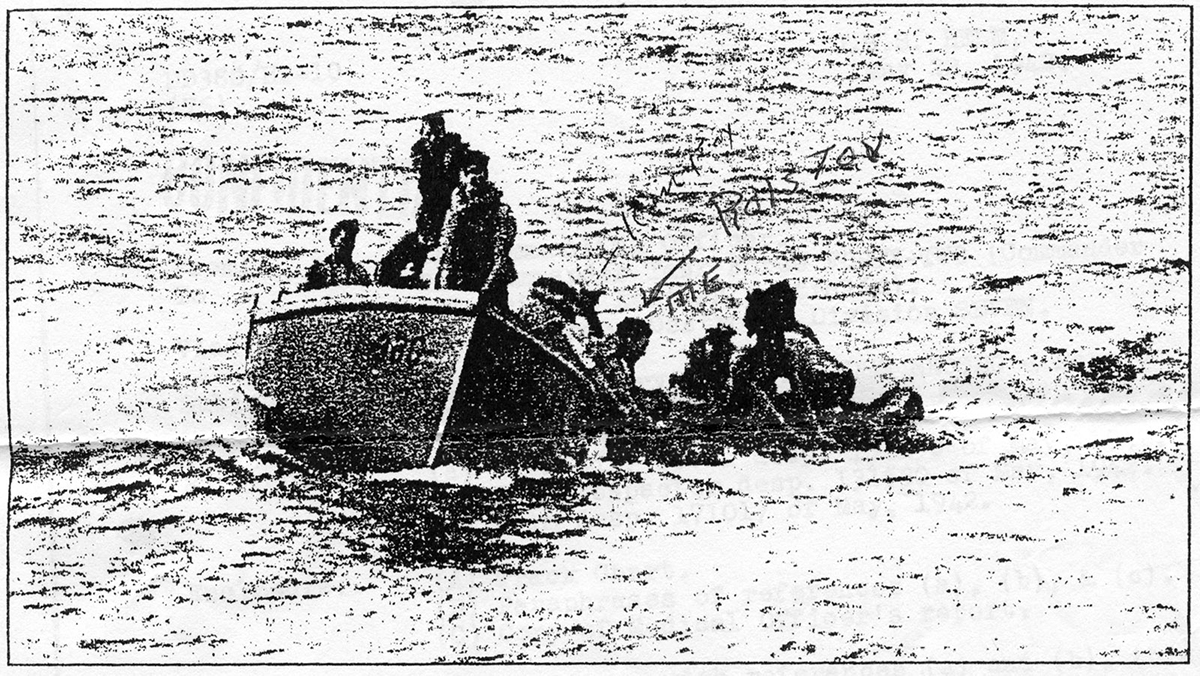 Survivors of the USS Neosho being rescued. Image: Wikimedia.
Survivors of the USS Neosho being rescued. Image: Wikimedia.
In early June, the Helm arrived in Sydney where it tied up alongside the destroyer tender USS Dobbin. The troublesome Gunnery Director was fully repaired and radar installed. Despite being fitted with radar, no personnel were trained to operate it.
While this work was progressing, my father was invited to dinner with an Australian family … the Flynn’s of Camperdown*.
It was here that the realities of the War struck home:The eldest son, Jack, had been wounded in the bombing of Darwin; while Ces Priestly, (who was the husband of the eldest daughter, Alice) had been captured by the Japanese in Singapore, and the second youngest daughter, Joan, had just received word that her husband, Jack Lewis (who was on board HMAS Perth), was missing, believed killed. Even at such a terrible time, the Flynn family were warm and welcoming to a lonely sailor from Illinois.
Bill was smitten with the youngest of the Flynn daughters, Mary, who was known as Dot. Over the next few weeks, he often took her to the pictures – always chaperoned by an elder sister.
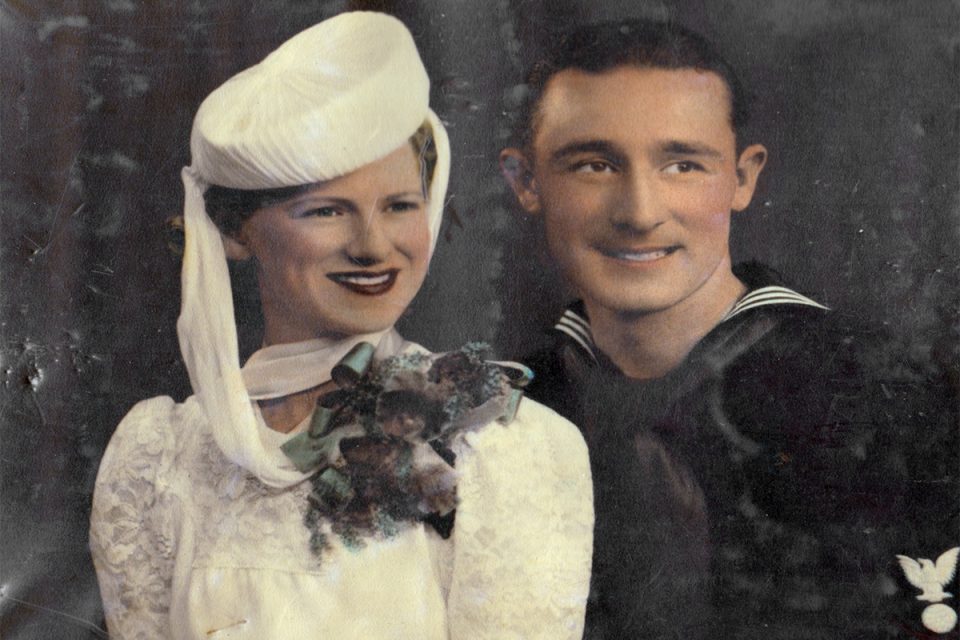
Mary ‘Dot’ Flynn and William A Dority USN on their wedding day. Image: Reproduced courtesy Russell Dority.
In mid-July, the Helm sailed for New Zealand where the American fleet was assembling for an amphibious assault on the island of Guadalcanal (Isatabu) in the Solomon Islands, east of New Guinea. Guadalcanal had been occupied by the Japanese since May, and they were building an airfield on Lunga Point which would increase their reach throughout the Pacific. The transports, which had sailed directly from the States, had to be re-loaded for combat. Kiwi dock workers were on strike, leaving the loading of the ships to the US Marines and the Navy. The Port of Wellington was in such chaos that the invasion had to be delayed by a week.
On 22 July, the fleet sailed for Fiji, for a landing rehearsal and to take on more crew members (including radar technicians). Bill was shocked by the inexperience of the new officers. They were known as the ‘90 Day Wonders’.
The fleet then set sail for Guadalcanal and the nearby island of Tulagi, arriving on 7 August 1942.
Bad weather meant the landings on Guadalcanal went virtually undetected by the Japanese and it wasn’t until the early afternoon that they attacked the fleet with Mitsubishi torpedo bombers and Zero fighters. Bill was most impressed by the Australian heavy cruisers, HMAS Australia and HMAS Canberra, using the tactic of firing their main armament into the water which caused the Japanese to divert and therefore, lose their aim. Three Allied ships were badly damaged during the attack. The Allies fought off numerous attacks over the next 24 hours. Bill recalled that the combination of the heat and being at ‘Battle Stations’ for such a long time was utterly exhausting.
On the night of 8 August, the fleet split into two sections: The Eastern Force (HMAS Australia and Canberra, and USS Chicago) with two destroyers, and the Northern Force (comprising the cruisers USS Vincennes, Quincy and Astoria and the destroyer USS Wilson and the Helm).
The night was wet, dark and stormy with the occasional flash of lightning. Those of the ships’ crew that could sleep, slept on the deck or wherever they could find a dry spot. Bill’s night combat station was manning the 48-inch (1200mm diameter) searchlight.
At about 01:30 AM, he spotted gunfire to the South East but didn’t know the cause. It was a Japanese force – seven cruisers and a destroyer, racing between the closely grouped Solomon island chain, undetected as they sailed past the guard ships USS Blue and Ralph Talbot, both equipped with the best radar and operators. While the Allies saw little of the Japanese, the Japanese saw them at 11,000 yards (10,000 metres) using nothing but binoculars and the naked eye (also known as the MK1 Eyeball).
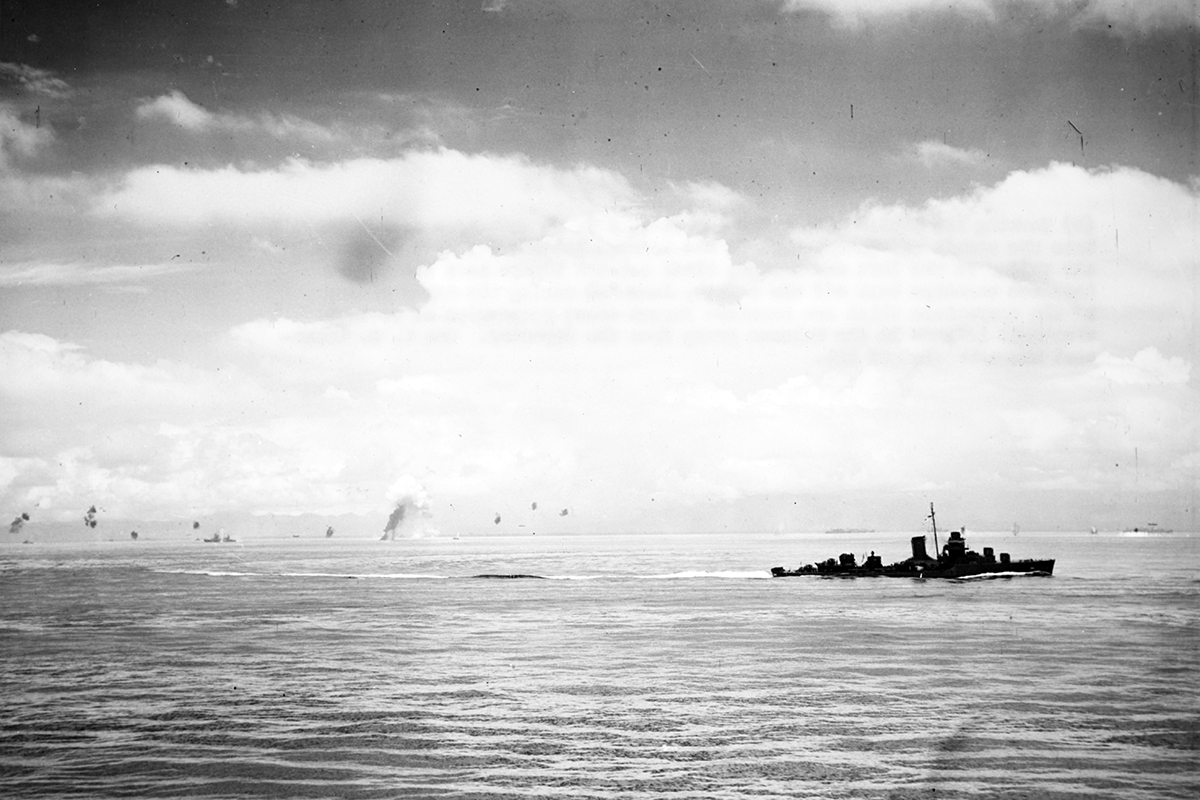 Ships maneuvering during the Japanese torpedo plane attack on the Tulagi invasion force, 8 August 1942. Image: U.S. Naval History and Heritage Command.
Ships maneuvering during the Japanese torpedo plane attack on the Tulagi invasion force, 8 August 1942. Image: U.S. Naval History and Heritage Command.
In what is known as the Battle of Savo Island, the Japanese attacked the Eastern Force, unleashing their secret weapon the deadly Long Lance Torpedo. This huge, stealthy Torpedo carried a 1000 lbs (450 kg) warhead and used compressed oxygen to burn its fuel leaving almost no telltale exhaust bubble trail.
HMAS Canberra and USS Chicago were immediate targets and the Canberra was badly damaged by a torpedo and gun salvos killing 84, including Captain Frank Getting. It’s claimed that none of the Japanese torpedoes struck Canberra and that a torpedo from USS Bagley may have. Bill said that this was the main topic of scuttlebutt among his destroyer division for a long time. The Canberra was beyond repair and was scuttled the next morning.
The Japanese now turned their attention to the North.
Bill’s first knowledge of a Japanese presence among the Northern Force came when he was blinded by their searchlights. This was immediately followed by salvoes from their 8-inch (20cm) guns and torpedoes coming from both sides. Within minutes the three American cruisers of the task force were blazing wrecks and 921 lives were lost.
The destroyer USS Wilson had also been damaged, but miraculously the Helm was untouched. The battle was over as quickly as it began and the Japanese were gone.
The Helm spent the rest of that night and most of the following day searching the shark-infested waters for survivors and taking them to the transports at Guadalcanal which were then ordered to retire leaving 11,000 US First Division Marines virtually stranded on the island to fight the Battle of Guadalcanal through to December 1942.
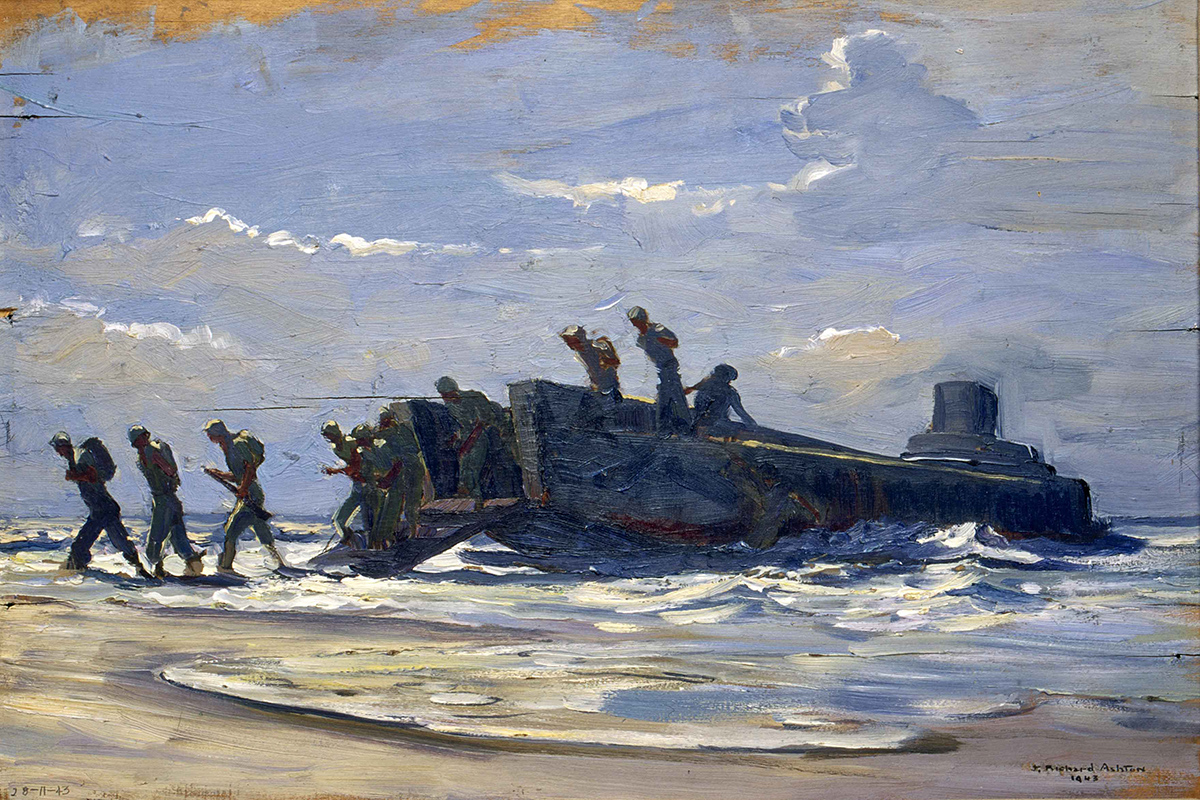
American Marines disembarking from an amphibious landing craft on to a beach. ANMM Collection 00004380, reproduced courtesy of J Richard Ashton Family.
1943 Back to the Helm
The Helm spent the next six months running supplies into Guadalcanal and escorting convoys to New Guinea. Early in 1943, Bill managed to get himself posted ashore in Sydney and promptly married Dot .
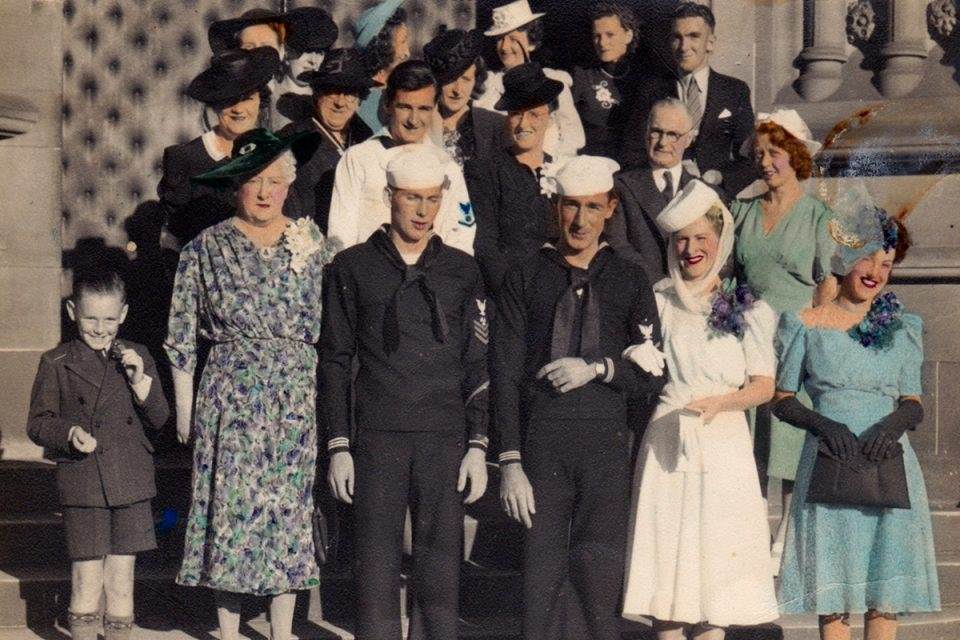
Mary ‘Dot’ Flynn and William A Dority USN on their wedding day. Image: Reproduced courtesy Russell Dority.
1944 Typhoon Cobra
Helm left San Francisco in May 1944 and arrived in Pearl Harbor five days later to join Admiral Mitscher’s Task Force 58 for the invasion of the Marianas, as part of the Battle of the Philippine Sea. The aerial part of this battle was nicknamed the ‘Great Marianas Turkey Shoot’ because of the destruction of hundreds of Japanese aircraft with few American losses.
After the battle Helm supported the invasion of Guam and then joined Admiral Halsey’s Task Force 38 to attack the occupied Philippines. As fleet escort in the Battle of Cape Engano the Helm witnessed the sinking of four Japanese aircraft carriers.
On the 25 October 1944, Helm sank Japanese submarine I46 and soon after, as part of Task Force 38, while sailing for Manus Island she was caught in Typhoon Cobra, the Great Typhoon of December 1944.
Fortunately, the ship’s luck held again when Bill was washed overboard from amidships and washed back on board on the stern, saved by the depth-charge racks. After being welcomed back on board, he was berated by the Captain for not wearing a lifeline. Bill always said that if he had been wearing a lifeline he would have been dragged alongside the ship and drowned. Three US destroyers sank, 30 ships were damaged in the storm and at least 776 souls were lost.
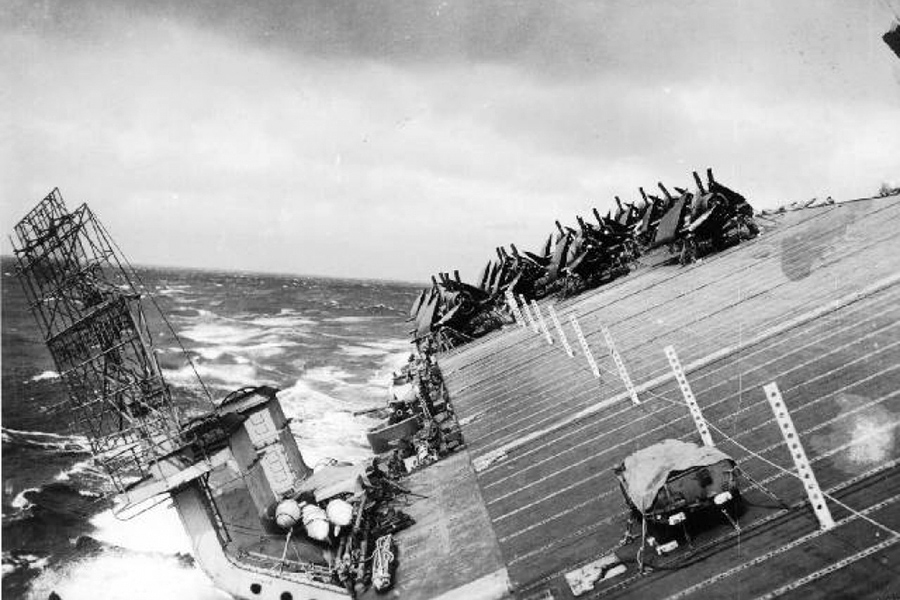
The flight deck of USS Cowpens during Typhoon Cobra, 18 December 1944. Image: USA National Archives.
1945 Fight for the Pacific intensifies
Early January 1945 saw the Helm escorting the invasion fleet to Lingayen Gulf in the Philippines and bombarding Japanese strongholds to allow 203,608 American troops to land. The fleet was attacked by a swarm of aircraft – the desperate Japanese were employing Kamikaze suicide pilots to crash their planes into enemy ships. Seven ships were hit, including the Helm, and more than 100 men were killed. But the Helm was lucky again, coming out only lightly damaged and no one was hurt.
Next stop for the Helm was the invasion of Iwo Jima as escort to the aircraft carrier USS Bismarck Sea. The Bismarck Sea was sunk in a frenzied Kamikaze attack. Helm once again escaped unscathed and could rescue survivors.
Underway in the final and biggest amphibious operation of the Pacific War, Helm spent ten weeks defending the fleet during the invasion of the island of Okinawa, Southern Japan. Following Okinawa, the ship assumed escort and patrol duties around the Philippines until the Japanese surrender on 15 August 1945.
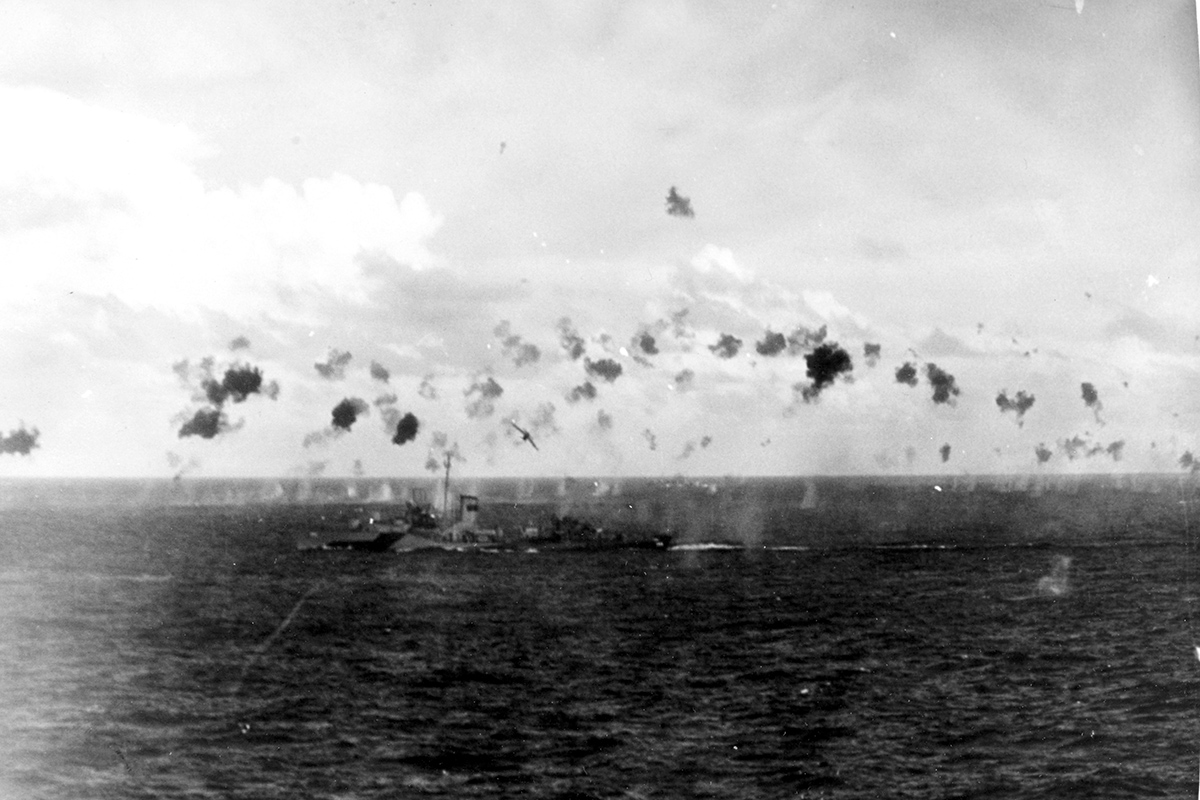
A Japanese plane makes a kamikaze attack on USS Helm, 5 January 1945. Image: USA National Archives.
Postwar
Bill asked permission to leave the Helm in the Philippines and managed to hitchhike his way back to Sydney as the Helm headed for Tokyo Bay. The ‘Lucky Ship’ had been in harm’s way from the first to the last day of the Pacific war.
During almost four years of combat, the Helm earned 11 battle stars, with no casualties or injuries to her crew. The Helm was decommissioned in 1946, and being of no more use to the Navy, was scrapped in 1947.
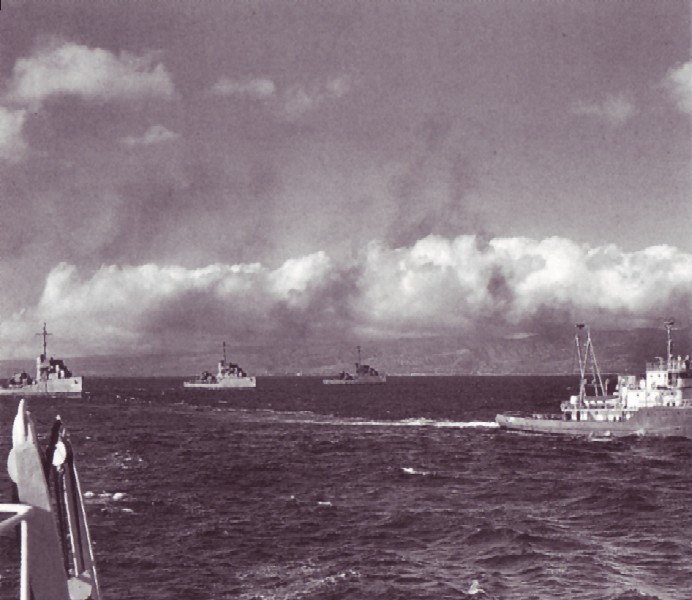
USS Helm and several other Bagley class destroyers were scrapped after the War. Pictured here 21 November 1947. Image: USA National Archives.
Is there such a thing as a lucky ship? Perhaps the Helm earned her luck by being well officered and having a very good, well-trained crew.
Bill Dority settled down in Sydney where he joined the motion picture industry. He was a founding member of the American Legion in Australia and the Australian/American Association. He also did volunteer work for the RSL, welcoming visiting US warships to Sydney.
He had four children and many grand and great-grandchildren.
Near the end of his life, the US Navy offered him a burial at sea but he chose to be buried, with full military honours, in Sydney beside Dot.
Credits
References
- Cover image: USS Helm alongside USS Makin Island during the Iwo Jima operation, 24 February 1945. Image USN History And Heritage Command.
- A 5 inch 38 caliber gun has a diameter of 5 inches (127mm) and a length of 38 x 5 inches = 190 inches (4825mm)
- USS – United States Ship
- USN – United States Navy
- HMAS – His Majesty’s Australian Ship
- Mike Carlton wrote about Joan (nee Flynn) and Jack Lewis in Cruiser: The Life and Loss of HMAS Perth and Her Crew.
- This story uses the pronoun ‘she’ to describe the USS Helm, it is Australian Government policy not to assign gender to ships, however, our guest author Russ Dority has asked to retain this style in his father’s story. As an American sailor of the 1930s and 40s, his father would have referred to USS Helm in this traditional way.
Author
Russell Dority
Russell Dority has worked as a cinematographer of over 30 years on feature films, commercials and documentaries. He has lectured at the Australian Film Television and Radio school as well as being a camera technician on Moulin Rouge, Star Wars Episode II: Attack of the Clones and Lord of the Rings.
His interest in military history lead him to write and direct numerous films and documentaries for the Royal Australian Navy. As part of this work, Russell won two Australian Cinematographer Society awards for the films Kapooka and First Up Last Down. Over the past two decades, his film career has taken him on board Russian Destroyers, to the United States Submarine School in Groton and the Royal Navy Submarine Base in Portsmouth.
Credits
Further Reading
- USA National Archives
- Helm (DD-388), Naval History and Heritage Command
Acknowledgements
- This story is part of the museum’s ‘War and Peace in the Pacific 75’ program.
- Presented by the USA Programs of the Australian National Maritime Museum.
- Funded by the USA Bicentennial Gift Fund.
